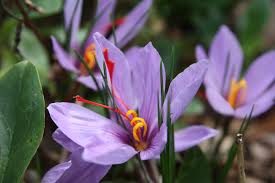This week I shall introduce you to the incredible history of Crocus sativus, or saffron. Native to parts of Asia – the golden stamen of this crocus were originally cultivated for use by the Ancient Greeks. They utilised it in everything, from masking smells and medical treatments to dyeing clothes for the wealthy. Regularly used in fertility rituals it is also mentioned in many of the death/rebirth stories of Greek mythology.
During the many centuries of cooperation between Greece and Rome, this bewitching spice conquered Roman culture and is believed to have been scattered through the streets as Nero entered Rome in 54AD. They also prized it as a culinary ingredient and brought it with them during their time in Britain until their retreat in the 5th century.
We didn’t see saffron in Britain again until the 14th century when it became a popular crop around Western Europe, with the majority of English saffron coming from Saffron Walden, East Anglia. During the Black Death epidemic in the mid 1300’s it was thought that saffron offered a miracle cure and high demand required huge imports of Non – European supplies too. So great was the craze for saffron and it’s health giving qualities that thieves sailing Mediterranean seas are believed to have ignored ships transporting gold for those taking saffron to Venice and Genoa. The saffron mania culminated in a fourteen week war between Basel and Austria when a 800lb shipment was taken hostage by a group of nobles. The hoard was eventually returned. At the same time in England, punishment for selling adulterated saffron was incarceration – before execution by immolation.
Cultivation of the crop continued in South East England until the late 1700’s when an influx of modern foodstuffs such as vanilla and chocolate drew the attention of middle and upper class consumers. In recent years there has been a resurge in English growing and native saffron can be purchased from Norfolk Saffron, along with others.
I finish this blog with a recipe inspired by Apicius, infamous Roman chef and inventor of many incredible dishes. He describes a meal of chickpeas, olive oil, cumin and coriander. This can be found adapted for the modern cook by the fantastically named blog Roman in the Gloamin’. But as we are still in the throws of winter I developed this gentle soup to nurture the most frazzled of souls and stomachs.
Ingredients
- big pinch of saffron threads
- 2 large leeks, finely chopped and cleaned
- 1tsp ground cumin
- 1tsp ground coriander
- half tsp ground black pepper
- vegetable stock cube
- 1 litre of water
- 180g red lentils
- 400g tin of chickpeas
- Take as large a pinch of saffron as you can bear and drop into a small dish. Pour on 2-3 tablespoonfuls of warm water and set aside.
- In a large pan – fry the sliced leeks in two tablespoons of olive oil until soft and translucent. Tip in the ground spices and stir through for a minute or so.
- Add the stock cube, water and red lentils. Stir again. Bring the contents to boil and leave to simmer – covered – for around ten minutes.
- Return to the saffron. The water should now have a deep red/golden colour. Tip the liquid, stamens and all, into the pan. Toss in the chickpeas and mix well. Replace the lid and simmer for another fifteen minutes or until the contents are cooked through. Add extra water if required. Season with salt and extra pepper as required.
- Once cooked remove three ladles of the soup into a separate container and blend. Pour back into the pan and combine to create a silky soup with a little texture. Drizzle with olive oil to serve.





This sounds lovely. I think I will try it with the addition of chilli as we like our food hot! I have tried to grow saffron twice but unfortunately the mice ate every single last bulb, so it would be good to know how people in past times kept the pesky mice away.
LikeLiked by 1 person